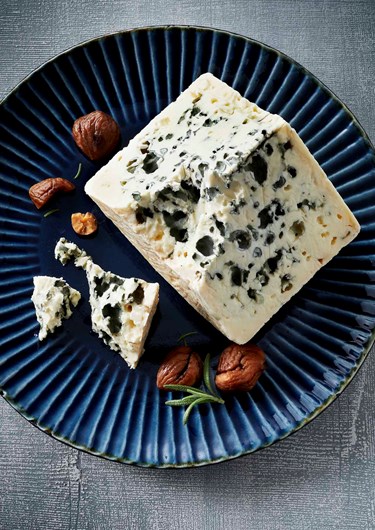
Roquefort
What is Roquefort?
Visually reminiscent of the limestone cliff sides in which it is aged, Roquefort illustrates French artisanry like few others. A favourite among kings and popes, this classic blue mould cheese is made from sheep’s milk and is easily recognised by its blue veins stretching across its moist and crumbly body. It is creamy and aromatic, complex and intense, with sharp and tangy nuances.
While the unique characteristics of Roquefort are largely imparted from aging in caves near Toulouse in the southern part of France, the milk of the Lacaune sheep also plays a large role in the outcome of flavours. Grazing on pastures in Occitanie, the sheep are known to produce milk of sturdy character, rounded flavours and a high yield.
Pair Roquefort with honey and zesty apples. The salty profile of Roquefort also sits in perfect tune with meat.
How Roquefort is made
Strict guidelines set the tone for how producers make Roquefort cheese, and following these is key to achieving the official label.
Tankers collect milk every day and deliver it to the creameries, fresh and unpasteurised. It is heated and poured into closed vats, then blended with a mixture of culture, penicillium roqueforti and rennet. Not only does this curdle the milk, the yeast also triggers the fostering of blue mould from the centre of the cheese. Once firm, the curd is milled and shaped by moulds that are left to drain in storage. A generous brine of salt is applied by hand, preventing an excessive growth of mould on the rind. Shortly after, the brined cheese is pierced with steel needles, allowing the blue veins to develop and breathe.
Naturally formed caves in the cliffs overhanging the village of Roquefort serve as the home of the cheese during aging, allowing it to absorb filtered moisture and flavours as time passes. Having aged for 20 days, the cheese is wrapped in foil, slowing the development of the blue mould. This allows the texture to soften, giving Roquefort its creamy consistency. After 3 months of ripening, the foil is removed, and the Roquefort is sent out to shops.
With no artificial flavours or preservatives, traditional Roquefort is unpasteurised and gluten free. However, it is not vegetarian due to the addition of animal rennet. Always be sure to check the label for additional information on ingredients.
*Castello UK does not produce or sell Roquefort at the moment, let us know if you would like to try this Castello cheese by leaving us a message.

Substitute
This cheese type with other amazing Castello range cheeses
Substitutes for Roquefort
In the long list of blue mould cheeses, all exude intense flavours and moist textures. When looking to substitute Roquefort, many cheeses bear a close resemblance.
Ranging from mild to pungent in taste, Gorgonzola offers a similar palate and consistency to Roquefort. This Italian classic boasts intricate flavours and great conformity, making it ideal in salads, on steaks or on your cheeseboard.
Vibrant, strong and full of personality, Stilton makes for a great stand-in, while also bringing qualities of its own. Slightly less intense than its French counterpart, traditional Stilton is robust with earthy hints of mushroom that subtly lace its strong and flavourful profile.
Curious about the world of cheese? Here's everything you need to know about how to store, serve and cut cheese!

Discover our cheeses
A world of surprising and indulgent sensations











